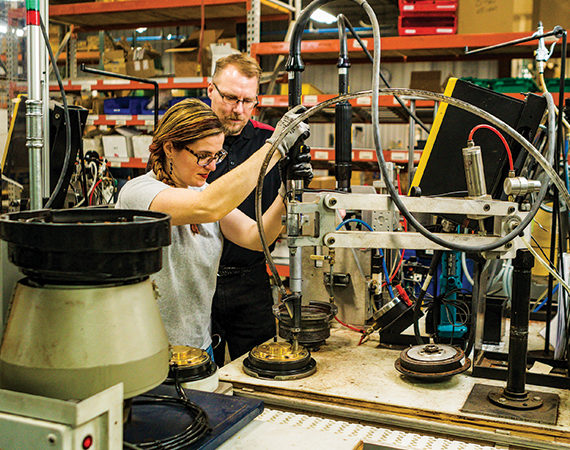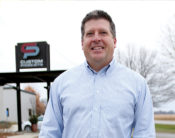Enterprise Minnesota recently launched a comprehensive eight-day program to help manufacturers develop continuous improvement leadership and a high-performance work organization. The High-Performance Manufacturing Program was designed by leading manufacturing organizations—the Society of Manufacturing Engineers, the Association for Manufacturing Excellence, and the Shingo Prize for Operational Excellence—to create a single standard for lean knowledge and certification. The program is often called the Lean Enterprise Certification Program (LECP) because it can culminate in a certificate of accomplishment, based on an exam.
The curriculum includes five days of classroom education, a two-day Kaizen event, and an optional “Lean Bronze Certification” exam.
Sessions include:
Principles of Lean Manufacturing – Lean 101 combines lecture and video simulation to introduce the principles and tools of lean, all designed to heighten attendees’ ability to eliminate manufacturing waste. Concepts include Eight Wastes, 5S, One-Piece Flow, Total Productive Maintenance, Cellular Production, Takt Time, Pull, Flow and Kanban, Point-of-Use Storage, Quick Changeover, Quality at the Source, Batch Reduction, Teams, Standardized Work, and Visual and Plant Layout.
Workplace Organization describes how 5S affects the appearance and functionality of a workplace. Participants perform an in-depth audit of workplace organization through a Workplace Scan. The unit further describes how 5S can improve workplace environmental health and safety. Participants learn how to apply the concepts they have learned and how to measure the impacts.
High-Performance Teams and Kaizen explains how to construct effective teams through trust, eliminate conflict, commit to ideas and gain consensus, hold each other accountable, and measure results. Participants learn how to use teams to change behaviors that then save time, money, and resources.
Standardized Work describes the importance and benefits of standardized work, along with associated measures and metrics. It introduces the tools of Standard Work: the combination sheet, spaghetti diagrams, job breakdown analysis, and time study.
Quick Changeover and Total Productive Maintenance illustrates how changeover improvement reduces or eliminates setup times through improved planning. Participants also learn how the Total Productive Maintenance (TPN) process increases productivity by improving safety, quality, delivery, cost, and creativity by all employees.
Pull/Kanban describes the difference between Pull and Push Systems. It involves how to manage demand to meet customer requirements, and how to locate and size markets in the system.
Principles of Cellular/Flow Manufacturing describes how to group manufactured products into product families, establish Takt time for a product family, review work sequence, and combine work to balance a production process.
Root-Cause Analysis and Problem-Solving instructs participants on the elements of a problem (methods, people, equipment, environment, materials, and systems) and the structured problem-solving process. It emphasizes the importance of standardizing the “One Best Way.”
Value Stream Mapping shows how this type of mapping is an overarching tool that gives managers and executives a picture of their companies’ entire production process—both value and non-value creating activities. Participants learn how to create a paper-and-pencil representation of every process in the material and information flow, along with key data.
Examination Preparation reviews the lean body-of-knowledge and exam structure, and includes practice examinations and test-taking tips and techniques in preparation for taking the SME Lean Bronze Certification exam.
Company Kaizen focuses all attendees on the resolution of a previously selected problem by applying the concepts of rapid continuous improvement (Kaizen) and the Plan-Do-Check-Act problem-solving methodology.
The following mini-profiles describe companies that have participated in this program and how they have incorporated the education into their cultures.
Kit Masters and Swan Machine – Perham
Kit Masters, Inc. and Swan Machine occupy a sprawling manufacturing complex representing more than 100,000 square feet in two Minnesota cities (Perham and Grand Rapids). Kit Masters manufacturers fan clutch kits for heavy-duty applications, while Swan Machine’s CNC milling technology manufactures parts for a wide array of industries—from industrial componentry to aftermarket AR-15 firearm parts. With 165 employees, lean manufacturing practices are an integral part of the companies’ cultures.
As plant manager for Kit Masters, Matt Riewer has watched the business double in size twice over, contributing to Swan Machine’s second plant that opened in Grand Rapids in 2017. He hoped the new expansion would attract viable candidates amid a workforce shortage. The investment has paid off, he says, while also providing ongoing challenges.
Faced with a limited workforce while in the middle of aggressive growth, Riewer and other company leaders knew they needed a better solution for the future.
“We used to schedule machines to run Monday through Thursday. Now, we might not have an individual there, so we have to schedule the individuals rather than the machines,” Riewer says.
An easy solution might be to just add another body, he continues, but lean thinking suggests, “it’s taking a step back and making sure that you even need that position. We should be asking, ‘can we make simple changes, and make things more efficient, so we don’t need quite as many people?’”
The organization reached out to Enterprise Minnesota for input.
“When we learned about the HPM possibility, we brought in an Enterprise representative—he heard us out and learned more about our bottlenecks and shortcomings,” Riewer recalls. In response, Enterprise Minnesota returned with a list of recommendations. At the top was HPM and its lean manufacturing processes.
Riewer describes the HPM education in a nutshell. “It’s mainly becoming efficient and doing more with less.”
The program revealed inefficiencies in the companies’ inventory management, which often held on to too much material. Thanks to today’s visual indicators, ground-level team members can see within seconds what items are understocked and then fill empty shelf space to a predetermined limit. Identifying exactly how many units of any given product should be maintained took a concentrated effort, but Riewer says the pull-based approach to inventory has paid back.
“That was one of the best things we’ve ever done. We used to call, page, and email across the facility. Now we have visual indicators.”
“Our goal is to get our product from spindle to the customer as fast as possible,” Riewer continues. “The time between there is where your cost is—your holding inven-tory, your lead times, and everything else. The people who know the best way to route things are really the people who have to do that on the floor.”
It didn’t come naturally at first. Floor-level staff who hadn’t experienced the HPM education didn’t always recognize the big picture. So, the companies, along with Enterprise Minnesota, worked with floor-level staff as well. Once the full team appreciated the potential, lean manufacturing became a company effort at every level.
Riewer speaks positively about the SME High-Performance Manufacturing course and his company’s long relationship with Enterprise Minnesota.
“Their staff is excellent,” Riewer says confidently. “Their instructors are awesome—they work with you, they make sure you understand, and I’ve never had anybody give a negative review on their HPM program.”
More than 150 Swan and Kit Masters team members have participated in Enterprise Minnesota sessions over the years, including HPM, and Riewer doesn’t hesitate to encourage fence-sitters to do the same.
“We have a partnership with Enterprise Minnesota. They’ve helped us grow and reduce cost,” Riewer says. “Any time we can become more efficient and reduce cost, we become a better company.”
Northern Contours – Fergus Falls
Northern Contours was founded in 1992 in Fergus Falls by Mike Rone & Duaine Miranowski with a business plan that intended to use “membrane pressing”—an innovation created in Europe—to manufacture cabinet doors more cost-effectively. It worked. Coupling that with wood veneer products, the company eventually expanded its product line to include pressed surfaces, panels, and more intricate products.
The company currently uses more than 420,000 square feet of space and employs more than 450 people in Fergus Falls, and also has facilities in Kentucky, Arizona, London, and Ontario.
Brett Hallberg entered Northern Contours at a time when the company had undertaken countless development programs without a cohesive plan toward completion. With the organization’s IT department, Hallberg helped implement software solutions that provided a sharper view of the work in progress. Since that early success, his position has become an embodiment of high-performance principles.
As the continuous improvement program manager, Hallberg works with team mem-bers at every level to fight an aggressive and unapologetic war on waste. “Any time you can remove that waste, you’re going to cut your costs,” Hallberg explains. “You have to stop wasting any of your core prod-uct; you have to stop wasting your labor; and you have to stop wasting time.”
Hallberg recently participated in one of Enterprise Minnesota’s HPM sessions and described the expert learning sessions as invaluable.
“The class itself and the content is fantastic, and it was very well covered and paired with great examples. Thanks to how interactive it was, and the large class, people could bounce ideas off one another.”
Policies at Northern Contours focus heavily on employee feedback and involvement practices that are reinforced through company-wide education on HPM concepts.
“It’s really helped our company realize—and the employees—that their ideas are valuable. It’s been a great program. It’s been very well received.”
Hallberg says lean practices benefit the entire company, even outside the manufacturing floor.
If your business works with a process of any kind, HPM will pay dividends. “Everyone would gain from understanding what lean brings,” Hallberg says. “Those methods can be applied to almost any environment.”
GVL Poly – Litchfield
Ten years ago, Allan Cronen was named CEO of GVL Poly when a new ownership group took over the Litchfield-based company. Cronen had watched the company for years from his position as an area banker and saw it was a business with potential. Asked today what motivated the purchase, he laughs and says, “It made a lot of money. It was a unique company. It was small and very profitable.”
Von Grotto founded the company in 1993 with his invention of the GVL Poly Snout, an innovation that significantly improved corn harvesting. His company grew steadily, but it had more potential.
When Cronen and his team acquired the company, they understood what was at stake. “We either had to land all of the OEM business making corn snouts or we had to land other business.”
So, they offered engineering and design services to manufacturing clients, but expansion wasn’t easy. Paired with a limited workforce in a rural community, GVL struggled to attract engineers and top talent.
Good fortune struck in 2012 when Bobcat relocated its Litchfield operation to North Dakota. Many of the left-behind employees chose careers with GVL Poly.
The Cronen-led company continued to push innovation. In 2015, it invested $1 million to install one of the largest 3D rotational printers in production. Cronen pounced again in 2015 when GVL became the first company in North America to install a Leonardo Smart Rotational Moulding Machine, designed and produced by Persico Rotomoulding of Italy. The impressive technology ran on a fully automated cycle, saving nearly 10 percent in material costs and 15 percent in energy.
The company partners with businesses in all industries to handle product development from concept to creation, employing 42 persons in its 51,000-square-foot facility. In a time-intensive industry like rotational polymer molding, efficiency is critical. Nathan Hulstein, an experienced engineer and today the president and COO of GVL Poly, saw room for improvement. He encouraged the firm toward lean manufacturing practices, and Cronen spotted an opportunity with Enterprise Minnesota to make it happen.
“We thought it was a great fit for us to help long-term employees learn something they typically wouldn’t without going back to a trade school or going back for more education. It really worked great for us,” Cronen recounts.
The Litchfield-based manufacturer hosted an HPM session in October 2018. As the host, case studies from GVL’s facility were examined, and valuable feedback came from the instructor, GVL employees, and even employees from other companies. The education inspired action; Cronen and Hulstein knew it now needed to be applied.
At GVL, Cronen says the SME High Performance Manufacturing course has helped their team learn to “speak the same language.” With everyone working together, the return on investment manifested in greater production efficiency, rapid problem solving, and error proofing that reduces loss through better quality control and diminished scrap waste.
“If you have scrap rates that get out of hand, it doesn’t matter how many you make; you can’t ship them,” Cronen says.
Hulstein, meanwhile, emphasizes that—in the same way a flowing stream becomes a deep gorge over time—it’s about small changes accumulating toward more.
“A lot of small things, when they’re all added together, equal great things in the end.”
Falcon Industries – Cosmos
In her 32 years as general manager of Minnesota operations and director of administration & finance at Cosmos-based Falcon Industries, Rhonda Gass has watched a lot of innovation come and go. Falcon supplies custom augers and auger flighting that are manufactured to customers’ specifications and designs, ensuring its customers receive the precise product required for their needs and equipment. Change—and growth—have been constants for the company, according to Gass.
“We can tackle pretty much anything that you want us to tackle,” she remarks. “We have equipment and personnel that will take on any job.”
Falcon does roughly 97 percent of its sales in the U.S. and Canada. And with 40 percent of the firm’s shares held by employees like Gass, the team truly does participate in the business’ achievements.
Since Falcon experienced the powerful effect of lean manufacturing practices in its Ohio-based branch, Gass asked Enterprise Minnesota’s experts to begin an assessment of the Cosmos facility and conduct one-on-one interviews. The quality of feedback from floor-level staff was impressive, and it highlighted opportunities for growth throughout the organization. But that wasn’t the end of the road.
Late 2018, Gass and the firm’s plant manager traveled to GVL Poly to complete a course in High-Performance Manufacturing.
It’s been a year since that education session, but the company hit a snag in July 2019. Before major takeaways from the session could be implemented, Falcon’s plant manager separated from the company, leaving its new ship without an engine. The loss was ill-timed, according to Gass, but the team’s new manager is officially on the job and motivated to make HPM work.
“I would say its value is for everybody because you want to get the company’s whole culture involved. By getting everyone on the same page, they can work together and get more accomplished. It’s only going to benefit them as an employee,” Gass says.


